
The creator-star of the multiple-award-winning Louis And Keely Live At The Sahara, the writer-director of the smash Sacred Fools original Watson: The Last Great Tale of the Legendary Sherlock Holmes (and its sequel), and the star of TV’s 3rd Rock From The Son join forces at the Pasadena Playhouse in Stoneface, a 99-seat hometown hit that’s been given a much-deserved L.A. regional theater transfer … and when was the last time you’ve seen that happen in our fair city?
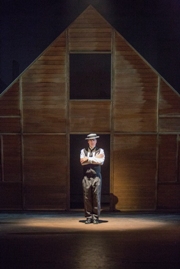 Written by Vanessa Claire Smith, directed by Jaime Robledo, and starring French Stewart in the title role, Stoneface aka The Rise And Fall And Rise of Buster Keaton, which originated two years ago at L.A.’s Sacred Fools Theatre, pays tribute to the genius that was silent screen legend Keaton.
Written by Vanessa Claire Smith, directed by Jaime Robledo, and starring French Stewart in the title role, Stoneface aka The Rise And Fall And Rise of Buster Keaton, which originated two years ago at L.A.’s Sacred Fools Theatre, pays tribute to the genius that was silent screen legend Keaton.
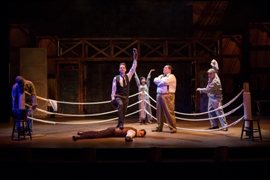 A surreal, time-traveling, often quite dark bio-dramedy, Stoneface not only gives Entertainment Weekly’s 7th-greatest director of all time and AFI’s 21st-greatest male star of all time his due; it does so in the most inspired and entertaining of ways, by taking actual sequences from Keaton’s silent classics and reimagining them as scenes from his life and career, though not necessarily in chronological order.
A surreal, time-traveling, often quite dark bio-dramedy, Stoneface not only gives Entertainment Weekly’s 7th-greatest director of all time and AFI’s 21st-greatest male star of all time his due; it does so in the most inspired and entertaining of ways, by taking actual sequences from Keaton’s silent classics and reimagining them as scenes from his life and career, though not necessarily in chronological order.
Stoneface introduces us to Joseph Schenck (Jake Broder), who hired Buster to work for his film studio, and to Roscoe “Fatty” Arbuckle (Scott Leggett), who like Buster went on to silent film stardom (though in Fatty’s case it was cut short by scandal).
We see how studio and audience reaction to Buster’s Civil War epic The General pretty much ended its creator-star’s directorial career, though the movie is now considered by many to be Keaton’s chef-d’oeuvre.
We witness Buster’s come-down from the superstar stratosphere, making two-reelers for the not-so-prestigious Educational Pictures, and later on, Buster’s battles with legendary studio head Louis B. Mayer (Pat Towne), who was not about to give one of his stable of stars any sort of creative freedom, let alone pick the projects he’d be working on.
A white-haired Charlie Chaplin (Guy Picot) even makes his appearance in Stoneface just as the real Charlie did in Keaton’s life when Buster was at just about his down-and-outest.
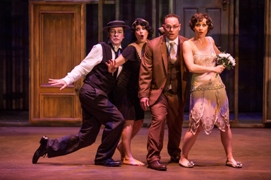 As for Keaton’s personal life, Stoneface gives us Buster’s marriage to Natalie Talmadge (Tegan Ashton Cohan), sister to film stars Norma and Constance, who following the couple’s divorce made damn sure that her ex would have no contact with his two sons, even going so far as to change their last name to hers.
As for Keaton’s personal life, Stoneface gives us Buster’s marriage to Natalie Talmadge (Tegan Ashton Cohan), sister to film stars Norma and Constance, who following the couple’s divorce made damn sure that her ex would have no contact with his two sons, even going so far as to change their last name to hers.
Stoneface doesn’t sugar-coat Buster’s battle with the bottle, though Robledo and the Stewarts do mine the comic possibilities of his marriage to his nurse Mae Scriven (Daisy Eagan), whom he wed during an alcoholic blackout. Still, it wasn’t until his marriage to wife number three, Eleanor Norris (Rena Strober, who doubles as Norma Talmadge) that the onetime superstar was able to begin salvaging his nearly defunct career.
Robledo and the Stewarts take a Felliniesque approach to Buster’s life, even going to far as to have not one but two Busters, one young and promising (Joe Fria), the other older though not necessarily wiser, the stark contrast between Stewart’s pancaked-and-rouged dissolution and Fria’s fresh-faced innocence exemplifying Buster’s “fall and rise” to perfection.
About half of Stoneface’s scenes are silent and occasionally supertitled with silent movie-style title cards projected above the stage, a device also used to set scenes and to reveal biographical information about Buster.
Even scenes with spoken dialog are given a silent-movie air, an effect enhanced by the production’s running soundtrack, an atmospheric original score performed live on the upright piano by its composer Ryan Johnson.
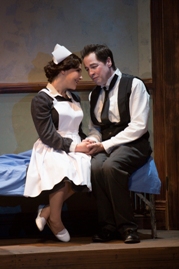 Stoneface makes ample use of videos and projections (designed by Ben Rock and Anthony Backman), beginning with Keaton’s 1920 short One Week, which introduces us to the physical comedy genius that was the then 24-year-old Buster, followed by an inspired sequence which has Stoneface’s cast of characters stepping one-by-one behind a movie screen, only to have their black-and-white cinematic selves appear onscreen in perfect sync—and in identical costumes. Another particularly stunning (and “bubbly”) projection sequence takes us underwater diving, if not quite literally.
Stoneface makes ample use of videos and projections (designed by Ben Rock and Anthony Backman), beginning with Keaton’s 1920 short One Week, which introduces us to the physical comedy genius that was the then 24-year-old Buster, followed by an inspired sequence which has Stoneface’s cast of characters stepping one-by-one behind a movie screen, only to have their black-and-white cinematic selves appear onscreen in perfect sync—and in identical costumes. Another particularly stunning (and “bubbly”) projection sequence takes us underwater diving, if not quite literally.
And speaking of inspired and stunning, in a scene based on one in Keaton’s classic film The Scarecrow, Buster and Fatty light each other’s cigars and pour each other’s drinks (among other assorted sight gags) using props they maneuver by pulling on cords attached to overhead pulleys.
In its ballsiest sequence, Stoneface has the cojones to recreate live onstage one of Buster’s most famous stunts, one in which the façade of a two-ton, two-story building fell right down upon Buster, who escaped without a scratch, the comedian having stood precisely where an open window would pass right over him.
French Stewart is, as he was at Sacred Fools in 2012, an absolutely superb Buster Keaton, abandoning the quirky, madcap, slapstick persona that won him legions of fans during his six seasons as 3rd Rock’s Harry The Alien the better to vanish inside Buster Keaton’s deadpan exterior, his oh-so expressive eyes revealing a raw rainbow of emotions.
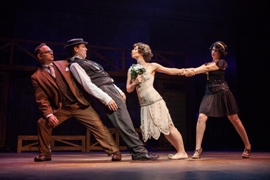 Fria is marvelous too as young Buster (and later Buster’s adult son), as is Leggett as Fatty, giving us both the brilliant comedian and the tragic victim of Hollywood’s morality police. Cohan’s piquant Natalie, Strober’s warm Eleanor (in addition to her fine bit as movie star Norma), Broder’s dynamic Schenk, Conor Duffy’s tiptop dual turn as director Edward Sedgwick and comedian George Jessel, Towne’s imperious Louis B. Mayer, and Picot’s wise, generous Chaplin are all finely drawn characterizations, as is the dryly humorous Mae, brought to life by Tony Award winner Eagan, whose addition to the Sacred Fools cast gives Stoneface at the Pasadena Playhouse an extra bit of Broadway star power.
Fria is marvelous too as young Buster (and later Buster’s adult son), as is Leggett as Fatty, giving us both the brilliant comedian and the tragic victim of Hollywood’s morality police. Cohan’s piquant Natalie, Strober’s warm Eleanor (in addition to her fine bit as movie star Norma), Broder’s dynamic Schenk, Conor Duffy’s tiptop dual turn as director Edward Sedgwick and comedian George Jessel, Towne’s imperious Louis B. Mayer, and Picot’s wise, generous Chaplin are all finely drawn characterizations, as is the dryly humorous Mae, brought to life by Tony Award winner Eagan, whose addition to the Sacred Fools cast gives Stoneface at the Pasadena Playhouse an extra bit of Broadway star power.
Physically, the production owes much to its talented team of designers, mostly reunited from the original Sacred Fools run for its Pasadena transfer, their work even more striking here on the significantly more expansive Playhouse stage.
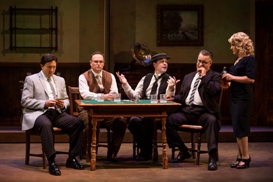 Joel Daavid’s set recalls images we’ve seen of old silent movie lots, a design exquisitely lit by Jeremy Pivnick in nostalgic, amber hues. Jessica Olson’s costumes and Jessica Mills’ wigs are like a history lesson in silent movie-era fashion and hair. As for sound designer (and Stoneface newcomer) Cricket S. Myers, they don’t get any better than the Tony Award nominee.
Joel Daavid’s set recalls images we’ve seen of old silent movie lots, a design exquisitely lit by Jeremy Pivnick in nostalgic, amber hues. Jessica Olson’s costumes and Jessica Mills’ wigs are like a history lesson in silent movie-era fashion and hair. As for sound designer (and Stoneface newcomer) Cricket S. Myers, they don’t get any better than the Tony Award nominee.
Add to this the top-drawer contributions of fight director Mike Mahaffey (and fight captain Fria) and a tireless backstage/onstage crew and you’ve got quite a production team.
Working behind the scenes are production stage manager Susie Walsh, general manager/production manager Joe Witt, technical director Brad Enlow, and company manager Kristen Hammack.
In reviewing Stoneface back in 2012, I wrote:
“Though a significant number of Los Angeles World Premieres seem to vanish in the mists of memory once the final curtain has fallen, my guess is that Stoneface will have a considerable life post-Sacred Fools. Still, it’s hard to imagine it being nearly as perfectly staged without Robledo and the Stewarts encoring their work. This may be one regional theater production that will have to come as a package deal.”
Thank you Sheldon Epps and the Pasadena Playhouse for making this reviewer’s prediction a reality.
Pasadena Playhouse, 39 South El Molino Ave., Pasadena.
www.pasadenaplayhouse.org
–Steven Stanley
June 11, 2014
Photos: Jim Cox
Tags: Buster Keaton, French Stewart, Los Angeles Theater Review, Pasadena Playhouse, Stoneface, Vanessa Claire Stewart


 Since 2007, Steven Stanley's StageSceneLA.com has spotlighted the best in Southern California theater via reviews, interviews, and its annual StageSceneLA Scenies.
Since 2007, Steven Stanley's StageSceneLA.com has spotlighted the best in Southern California theater via reviews, interviews, and its annual StageSceneLA Scenies.







 COPYRIGHT 2024 STEVEN STANLEY :: DESIGN BY
COPYRIGHT 2024 STEVEN STANLEY :: DESIGN BY